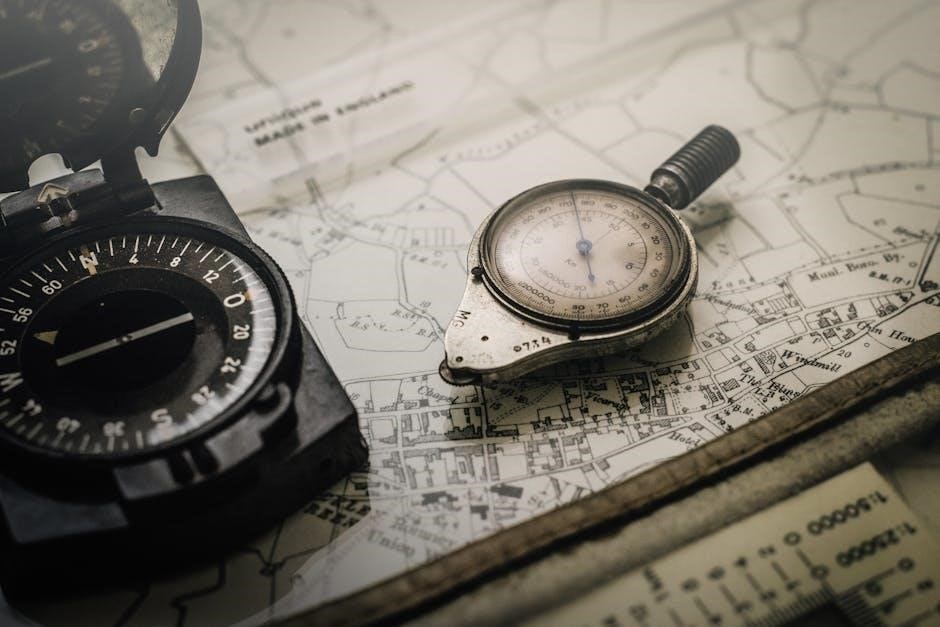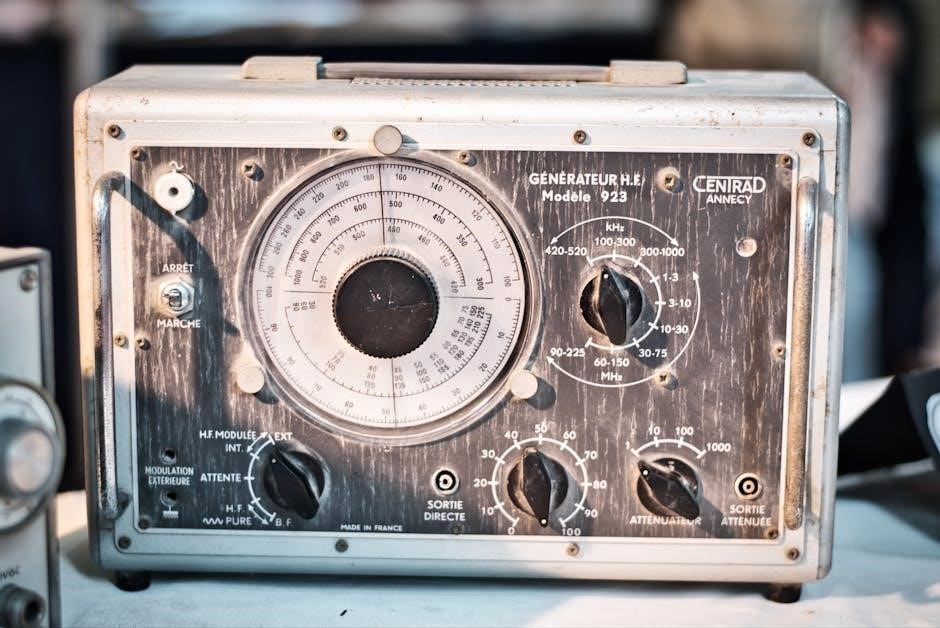
The RPE Scale is a widely used tool to measure perceived exertion during exercise‚ helping individuals gauge intensity and effort. It is both a primary and adjunctive measure‚ validated for accuracy and practicality in various fitness and clinical settings.

1.1 What is the RPE Scale?
The RPE (Rate of Perceived Exertion) Scale is a subjective measure used to assess the intensity of physical activity. It gauges how hard an individual feels they are working during exercise. The scale‚ often referred to as the Borg RPE Scale‚ typically ranges from 6 to 20‚ with 6 indicating “no exertion at all” and 20 representing “maximal exertion.” This tool allows individuals to communicate their effort level‚ helping to tailor workouts to their fitness goals. It is widely used in fitness‚ rehabilitation‚ and sports to monitor and adjust exercise intensity. The RPE Scale is simple yet effective‚ providing a personalized approach to training and ensuring safe progression. Its versatility makes it a valuable resource for both professionals and individuals seeking to optimize their physical performance.
1.2 Importance of the RPE Scale in Fitness and Rehabilitation
The RPE Scale is a crucial tool in fitness and rehabilitation‚ enabling individuals to gauge their exercise intensity accurately. It helps personalize workouts‚ ensuring they are challenging yet safe. In clinical settings‚ the RPE Scale is particularly valuable when heart rate measures are unreliable‚ such as in patients with certain health conditions. It allows professionals to monitor progress and adjust training plans effectively. By providing a subjective yet reliable measure of exertion‚ the RPE Scale helps prevent overtraining and promotes sustainable fitness goals. Its simplicity and effectiveness make it an essential resource for both fitness enthusiasts and rehabilitation specialists‚ ensuring tailored and adaptive exercise programs.

History and Development of the RPE Scale

The RPE Scale was developed by Gunnar Borg in 1970 as a tool to measure perceived exertion. It evolved from earlier models to improve accuracy and usability‚ becoming a standard in fitness and rehabilitation.
2.1 The Contribution of Gunnar Borg
Gunnar Borg‚ a Swedish psychologist‚ pioneered the development of the RPE Scale in 1970. His work introduced a standardized method to measure perceived exertion‚ revolutionizing exercise assessment. Borg’s scale initially ranged from 6 to 20‚ correlating with heart rate‚ and was designed to help individuals and clinicians gauge physical effort accurately. His research emphasized the importance of subjective feedback in understanding exercise intensity‚ making the RPE Scale a cornerstone in fitness and rehabilitation; Borg’s contributions laid the foundation for modern adaptations of the scale‚ ensuring its relevance and applicability across diverse populations and settings.
2.2 Evolution of the RPE Scale Over Time
The RPE Scale has undergone significant evolution since its introduction by Gunnar Borg in 1970. Initially‚ the Borg 6-20 scale was developed to correlate perceived exertion with heart rate. Over time‚ modifications were made to improve usability‚ leading to the creation of the Modified Borg Scale‚ which simplified the range and added clearer descriptors. Additionally‚ the Original 15-Point Scale emerged as another variation‚ further refining how exertion is measured. These adaptations have enhanced the scale’s applicability in diverse settings‚ such as clinical rehabilitation and sports performance. The evolution reflects ongoing efforts to make the RPE Scale more accessible and effective for assessing exercise intensity across different populations and contexts.
Types of RPE Scales
The RPE Scale includes the Borg 6-20‚ Modified Borg‚ and Original 15-Point versions. Each offers distinct ranges and descriptors to measure perceived exertion accurately.
3.1 The Borg 6-20 RPE Scale
The Borg 6-20 RPE Scale‚ developed by Gunnar Borg‚ is a widely recognized tool for measuring perceived exertion. It ranges from 6 to 20‚ with 6 indicating “no exertion at all” and 20 representing “maximal exertion.” This scale is designed to correlate with heart rate and oxygen uptake‚ making it a reliable indicator of physical intensity. It is commonly used in fitness training‚ clinical settings‚ and sports performance to gauge an individual’s effort level. The scale is simple yet detailed‚ allowing users to accurately assess their exertion and adjust their workouts accordingly. Its versatility makes it a valuable tool for both professionals and individuals monitoring their exercise intensity and progress.

3.2 The Modified Borg RPE Scale
The Modified Borg RPE Scale is an adapted version of the original Borg Scale‚ designed to simplify and enhance its practicality. It ranges from 0 to 10‚ with descriptors such as “very‚ very light” (0) and “very‚ very hard” (10). This scale focuses on perceived exertion‚ breathing difficulty‚ and muscle fatigue‚ making it particularly useful in clinical and rehabilitation settings. It is often used to assess effort in patients with respiratory or cardiovascular conditions‚ where traditional heart rate monitoring may be less reliable. The Modified Borg Scale provides a more nuanced and user-friendly approach‚ allowing individuals to communicate their exertion levels effectively. Its simplicity and adaptability have made it a popular choice in both fitness and medical environments.
3.3 The Original 15-Point RPE Scale

The Original 15-Point RPE Scale is a foundational tool for assessing perceived exertion‚ ranging from 6 to 20. Each number corresponds to specific physical sensations‚ such as “very‚ very light” (6) and “maximal effort” (20). This scale was developed to provide a detailed and sensitive measure of exercise intensity‚ allowing individuals to communicate their effort levels accurately. It is widely used in fitness‚ sports‚ and rehabilitation settings to tailor workouts and monitor progress. The scale’s design helps individuals avoid undertraining or overexertion by aligning their subjective experience with objective intensity levels. Its widespread adoption is due to its simplicity and effectiveness in guiding personalized training plans and ensuring safe‚ effective exercise routines for diverse populations.

Applications of the RPE Scale
The RPE Scale is widely applied in fitness training‚ clinical rehabilitation‚ and sports performance to optimize workout intensity‚ ensure safety‚ and monitor progress effectively across diverse populations.
4.1 RPE in Fitness Training

The RPE Scale is a valuable tool in fitness training‚ helping individuals and trainers assess exercise intensity. It allows for personalized workouts by gauging how hard someone feels they are exerting themselves. This subjective measure is particularly useful for setting appropriate intensity levels‚ ensuring workouts are challenging yet safe. For example‚ an RPE of 7-8 often indicates moderate to hard effort‚ guiding participants to push themselves without overexertion. The scale also helps create balanced routines‚ as it accounts for individual differences in fitness levels. By using the RPE Scale‚ trainers can design programs that maximize progress while minimizing the risk of injury or burnout‚ making it a practical and effective tool for achieving fitness goals.

4.2 RPE in Clinical and Rehabilitation Settings
The RPE Scale is widely utilized in clinical and rehabilitation settings to monitor exercise intensity and patient progress. It serves as a reliable tool for assessing perceived exertion‚ particularly when heart rate measures are unreliable due to certain medical conditions. In rehabilitation‚ the RPE Scale helps tailor exercise programs to individual capabilities‚ ensuring safe and effective recovery. Clinicians use it to gauge patients’ exertion levels during physical therapy‚ adjusting workouts to avoid overexertion. The scale is especially valuable for patients with cardiovascular or respiratory limitations‚ as it provides a subjective yet accurate measure of effort. This approach fosters personalized rehabilitation plans‚ promoting adherence and optimal recovery outcomes while minimizing risks associated with overexertion.
4.3 RPE in Sports Performance
The RPE Scale is a valuable tool in sports performance‚ enabling athletes to optimize their training and competition efforts. By assessing perceived exertion‚ athletes can set precise training zones and monitor fatigue levels. Coaches use the RPE Scale to design personalized programs‚ ensuring athletes push their limits safely. It is particularly useful for activities where heart rate monitoring is impractical or unreliable. The scale helps athletes avoid overtraining while maximizing performance gains. In team sports‚ it fosters consistency and alignment among players‚ enhancing overall team performance. The RPE Scale’s subjective nature allows for real-time adjustments‚ making it an indispensable asset in achieving peak athletic conditioning and competitive success.
Practical Use of the RPE Scale
The RPE Scale is a practical tool for monitoring exercise intensity‚ helping individuals adjust their workouts based on perceived exertion. It guides training plans and effort levels effectively.
5.1 How to Use the RPE Scale During Workouts
Using the RPE Scale during workouts involves monitoring and rating your perceived exertion levels. Start by understanding the scale‚ which ranges from 6 to 20‚ with 6 being “no exertion” and 20 being “maximal effort.” Before beginning‚ familiarize yourself with the scale to accurately assess your effort. During exercise‚ periodically check in with your body to gauge fatigue‚ breathing‚ and muscle tension. For example‚ if you rate your effort at 12-13‚ it indicates “somewhat hard” exertion. Adjust your intensity based on your RPE to stay within your target range. This method allows for real-time feedback‚ ensuring workouts are challenging yet sustainable. Consistency in using the scale helps track progress and maintain optimal training intensity.
5.2 Creating a Training Plan Based on RPE
Creating a training plan using the RPE Scale involves tailoring workouts to individual fitness levels and goals. Begin by assessing your current fitness level using the RPE Scale to determine baseline intensity. Set specific‚ measurable objectives‚ such as improving endurance or strength. Divide your plan into phases‚ with gradual increases in intensity based on RPE ratings. For example‚ start with moderate effort (RPE 12-13) and progress to higher intensities (RPE 16-17) as fitness improves. Incorporate rest and recovery periods to avoid overtraining. Use the Borg 6-20 Scale to guide session planning‚ ensuring workouts remain challenging yet sustainable. Regularly review and adjust the plan based on progress and RPE feedback to maintain effectiveness and prevent plateaus.
5.3 Monitoring Progress with the RPE Scale
Monitoring progress with the RPE Scale involves regularly tracking changes in perceived exertion during workouts. Over time‚ individuals can observe improvements in endurance and strength as tasks that once felt challenging become easier. For example‚ an exercise rated as “very hard” (RPE 17) may eventually feel “hard” (RPE 15) as fitness levels increase. Consistently logging RPE scores helps identify trends and plateaus‚ allowing for timely adjustments to training plans. By comparing RPE ratings over weeks or months‚ individuals can gauge progress and stay motivated. This method also helps ensure workouts remain effective and aligned with fitness goals‚ providing a clear measure of improvement. Regular monitoring with the RPE Scale enhances the accuracy of training adjustments and supports long-term success.

Benefits and Limitations of the RPE Scale
The RPE Scale offers a practical‚ non-invasive way to measure exertion‚ making it accessible for various fitness levels. However‚ its subjective nature may lead to inconsistent results.
6.1 Advantages of Using the RPE Scale
The RPE Scale is a practical and non-invasive tool for assessing exercise intensity‚ making it accessible for individuals of all fitness levels. It allows users to gauge their exertion without relying on expensive equipment‚ ensuring cost-effectiveness. The scale is highly adaptable‚ suitable for both fitness training and clinical rehabilitation settings. It provides immediate feedback‚ helping individuals optimize their workouts and avoid overexertion. Additionally‚ the RPE Scale enhances consistency in training by offering a standardized method to track progress over time. Its simplicity and effectiveness make it a valuable resource for personal trainers‚ athletes‚ and rehabilitation specialists alike‚ ensuring safe and efficient exercise routines.
6.2 Limitations and Potential Drawbacks
The RPE Scale‚ while valuable‚ has limitations. Its subjective nature means results can vary between individuals‚ as perceptions of exertion are influenced by personal fitness levels and psychological factors. It may lack precision compared to physiological measures like heart rate or lactate levels‚ particularly in clinical settings where exact intensity is critical. Additionally‚ the scale’s reliance on user understanding and honesty can lead to inaccuracies. Different versions of the RPE Scale‚ such as the Borg 6-20 and modified scales‚ can cause confusion and inconsistency in application. Furthermore‚ its effectiveness depends on proper education and interpretation‚ as misuse can lead to overestimation or underestimation of effort. These factors highlight the need for clear guidelines to enhance reliability and accuracy when using the RPE Scale.
The RPE Scale is a valuable‚ validated tool for measuring perceived exertion‚ aiding in fitness and rehabilitation. Its subjective nature offers practicality but requires careful interpretation for accuracy‚ ensuring its continued relevance in exercise science and clinical practice.
7.1 Summary of Key Points
The RPE Scale is a fundamental tool for assessing perceived exertion‚ developed by Gunnar Borg‚ with versions like the Borg 6-20 and Modified Borg scales. It measures exercise intensity‚ aiding in fitness training‚ rehabilitation‚ and sports performance. The scale helps create personalized training plans‚ monitor progress‚ and adjust efforts based on individual feedback. Its applications span clinical settings‚ where heart rate measures may be unreliable‚ and sports‚ where it optimizes performance. While subjective‚ the RPE Scale is practical and effective‚ offering insights into physical exertion. Its evolution and validation ensure its relevance in exercise science‚ making it a versatile and essential tool for both professionals and individuals seeking to enhance their workouts and recovery processes.
7.2 Future Implications of the RPE Scale
The RPE Scale is poised to play a pivotal role in advancing personalized fitness and rehabilitation. Its integration with wearable technology could enhance real-time monitoring‚ offering tailored workout adjustments. Future research may explore its application in lactate-threshold training‚ bridging the gap between perceived exertion and physiological markers. The scale’s adaptability to diverse populations‚ including children and clinical patients‚ underscores its potential for widespread use. As digital health evolves‚ the RPE Scale could become a cornerstone of holistic wellness programs‚ combining subjective feedback with objective data for better outcomes. Its continued validation and refinement will ensure its relevance in both clinical and sports settings‚ making it an indispensable tool for optimizing performance and recovery in the years to come.

